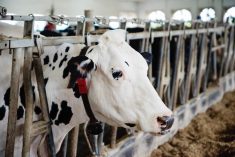Since 2002, Alberta milk producers have seen their production increase by three per cent in the first 10 years and then explode to a 30 per cent increase in the next decade.
“What (this) is really saying is that in the next 10 years, our industry is going to grow,” Bill Beisal, transportation co-ordinator for Alberta Milk, said at the organization’s recent fall producer meeting in Lethbridge.
The number of producers has decreased from 843 to 470 in 2023-24, routes have increased from 126 to 175, receiving bays have decreased from 24 to 12 and B-trains went from zero in 2002 to nine in 2023 and a dozen in the last couple of years.
Read Also

Grain farming’s hard times expected to continue
Rabobank says it will be two more years before North American grain farmers achieve break-even due to “monster” supplies and “sticky” crop input prices.
WHY IT MATTERS: Transportation efficiencies are needed for cost savings in Western Canada’s dairy sector.
Beisal said there are 65 milk trucks on the road every day in Alberta, and two million litres of milk are moved every week between provinces.
“I will admit, at times we have to pay more, because logistically, we can’t do it the way that we want to do it, real efficient,” he said.
“When I talk about moving your milk out of province, we’ve got all these loads lined up, and it goes out and hauling companies are lining up their drivers. The days we can stop on a dime and turn everything around like we could 20 years ago are over, but we can still do that once in a while. But the hauling companies really don’t like it because they lose drivers,” said Beisal.
The transportation committees of the western Canadian milk groups meet every Thursday, projecting movement from six months to a year in advance. Each province has its own body, but they have to be on the same page for transportation efficiencies.

Interprovincial milk movement has increased from 33 million litres in 2016-17 to 127 million litres in 2024-25.
“We have a pretty good idea of what we’re going to do and how we’re going to do it,” he said.
“As each week comes up, orders can change easily by one million, two million.”
For example, the week before Alberta Milk’s fall meeting saw an 800,000 litre increase in the Western Milk Pool.
Unfortunately, at times there is the need to “dump” milk for a variety of reasons: milk production exceeding quotas in supply management, market fluctuations for demand such as the COVID-19 pandemic in 2020, supply chain disruptions and the perishable nature of milk. All of these are factored into transportation costs.
“Why does Alberta dump all the milk? I know that’s a swear word here, but there’s a process,” Beisal said.
“Why would we keep moving milk all the way to Manitoba out of Alberta? Why then would we have Manitoba dispose of whole milk? If we have to dispose of whole milk, let’s not move it. Let’s not spend that transportation money. Let’s dispose of it where it’s the most economical. We hate that, but that’s the absolute last thing that happens with your milk, when we have no home for it.”
The western provinces cost share and pool provincial and interprovincial transportation costs.
Alberta and British Columbia each pay 35 per cent of transportation costs and Saskatchewan and Manitoba pay roughly 17 and 13 per cent.
He said it costs approximately $1 million a month to export milk out of Alberta using a transportation rate formula that takes into account hours and kilometres involved.
Alberta and Manitoba have multiple haulers (12 to 13) that deliver to multiple plants. Saskatchewan has one hauler and one plant, while B.C. has one hauler to deliver to multiple smaller plants.
“A lot of that is to give the industry, not only just the producers, but processors as well, the confidence that we can cost share … we can do this together. It’s just going to take a little bit of work,” said Beisal.
The opening of Dairy Innovation West this year in central Alberta is expected to be a game changer for milk transportation.
Raw milk volumes are projected to increase from 43 million litres in July 2026 to 321 million in 2030, which is expected to bring logistical cost savings.
Beisal said Alberta Milk’s success has forced it to pivot in the last 10 years as production grew by 30 per cent.
“Now we’re starting to deal with more and more constraints — time constraints, volume constraints, equipment constraints, a lot of things in your transportation system that needs some improvement.
“We need to find out how to make it better. We’re looking at policy. We’re going to talk with with the processors. We’re going to see how is there anything that they have for us? What can we do for them? What can the haulers do to make this a better network and asset optimization. How can we do that less expensive?”















